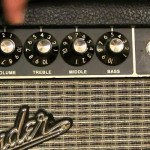Language
How To Quickly Get A Good Sound From Your Tube Amp
We all know that most tube amps have a certain sweet spot where you get great sustain, good dynamics, a rich tone, and a full sound. In addition, you do not have to press the guitar so hard to enjoy a good sound when playing it. Nevertheless, it is not the same for all amps; some amps are always meant to have all things dimmed and sound nice when pushed equally. Moreover, other amps may sound best up on a gain knob and maybe halfway to two-thirds up when the volume is adjusted well.
As a guitar player, you need to consider some factors, which play into this quality sound as such as how hot you have pickups, the number of pedals within the chain, and much more. However, the main focus here is on the amp itself where you will find where it does perform best. Here is a quick and easy method for finding these sweet spots if you want to play for your amp.
There are two aspects to learn about this namely volume and gain.
 Quilter Labs Mach 2 8-inch Combo Amp Review[/caption]
[caption id="attachment_1945" align="alignleft" width="150"]
Quilter Labs Mach 2 8-inch Combo Amp Review[/caption]
[caption id="attachment_1945" align="alignleft" width="150"] Ampeg BA-112 v2 Combo Bass Amplifier Review[/caption]
[caption id="attachment_1995" align="alignleft" width="150"]
Ampeg BA-112 v2 Combo Bass Amplifier Review[/caption]
[caption id="attachment_1995" align="alignleft" width="150"] Great Guitar Amps For Classic Rock[/caption]
Great Guitar Amps For Classic Rock[/caption]
Volume Knob
When you start with the volume of the amps that is almost off, you can barely hear its sound. Why say this? It will definitely sound thin and somehow choked; since it has a low volume with no signal that is passing through to these power tubes. Through the process, you can begin turning it up slowly, pausing to listen if you want the best sound. You will notice that this sound is being full bodied. Nevertheless, at a given point, the tone will not get thicker or even more full-range, but just louder. At this point, where your amp starts to achieve this full-bodied tone can be described as a “sweet spot” for the volume. You should note that you may get other sweet spots, which depends on the tone you prefer as well as the response you would want much from your amp.Gain Knob
If you want to use your amp especially for dirty sounds and clean, you should repeat the above procedure with your gain knob. How is this possible? With the gain low, you should have a pretty clean tone whenever you do turn it up while reducing the chances of it will getting more distorted. Nonetheless, at a given point you might notice that the tone does not sound more “distorted,” as you may think but its sounds are increasingly compressing and have a possibility of becoming fuzzier. At this point, you will notice that your amp has reached maximum distortion with no over compression or fizziness leading to a “sweet spot” for the gain. Some of the vintage-style amps do not have a master volume or gain knob, as they only way of getting more grit is by turning up the amp to blistering levels. When you have these amps, you may want to go for that nice “breakup edge” sweet spot that will get your tone gritty whenever you are digging into it at the same time staying relatively clean before using pedals for an extra distortion and overdrive. It is important that you know your amp sweet spot(s) to opens up a tonal possibilities world as it is worth taking some time when exploring these settings.Final Thoughts ...
Like any other piece of music gear, the best way to get a great sound is by fully exploring all of its facets. From pedals to guitars and, of course, amps, they each have their own quirks. If you're new to your tube amp, follow the tips above and you'll be sure to dial in a great sound in no time.Your Turn to Sound Off!
What settings do you use on your tube amp?Let us know in the comment section below!
Other Stories You Might Like ...
[caption id="attachment_7406" align="alignleft" width="150"] Quilter Labs Mach 2 8-inch Combo Amp Review[/caption]
[caption id="attachment_1945" align="alignleft" width="150"]
Quilter Labs Mach 2 8-inch Combo Amp Review[/caption]
[caption id="attachment_1945" align="alignleft" width="150"] Ampeg BA-112 v2 Combo Bass Amplifier Review[/caption]
[caption id="attachment_1995" align="alignleft" width="150"]
Ampeg BA-112 v2 Combo Bass Amplifier Review[/caption]
[caption id="attachment_1995" align="alignleft" width="150"] Great Guitar Amps For Classic Rock[/caption]
Great Guitar Amps For Classic Rock[/caption]
